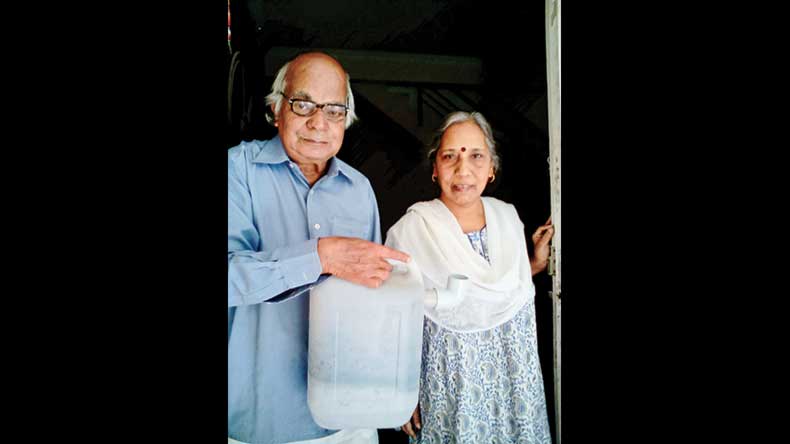Raghavendra Desai is a 75-year-old retired mechanical engineer living a quiet life in north Maharashtra’s Nashik city, 165 km from Mumbai. But what sets him apart from other septuagenarians is his dream for Swachh Bharat—to see India pollution-free. He and his wife have dedicated 12 years on researching and developing a unit which apparently reduces vehicular pollution by 80%. Not just that, the unit apparently helps increase the emission of oxygen from vehicles. The couple doesn’t have the money to get the technology patented.
With pollution levels reaching alarming proportions in Indian cities, the couple wants the government to give them a hearing and is even willing to transfer the technology free of cost to it.
The cost of each unit will not be more than Rs 300. It can be easily fitted to the exhaust of the vehicle.
“We are old people. We are not very well-versed with modern technology. We have been working on this since 2004. We even wrote an email to Narendra Modiji. But we haven’t yet received any reply from him. We have lab test reports. We are willing to transfer our research free of cost to the government so that it can make this available on a large scale. Modiji is a strong leader. We adore and respect him. If he comes to know about this, he will definitely solve our pollution problem. Please help us reach him. We don’t want any money. We want our country to respect the research that comes from common people, and we want people to use this research,” Raghavendra Desai and Sushama Desai told The Sunday Guardian over phone from Nashik.
The couple has developed a liquid chemical combination which reduces pollution once gases emitted from a vehicle pass through it. When asked about the details and the safety aspect, they refused to elaborate on the chemical components of the liquid. “If we tell you what chemicals we have used, we will give away our research. We want it to reach the right hands. All we can say is that the chemicals are easily available, they are inexpensive,” Raghavendra Desai said. Asked if the liquids were combustible, he said, “No, they are safe. They don’t pose any hazard to humans. They are not combustible.”
THE INSPIRATION
The couple, now settled in Nashik, stayed in Pune for most part of their lives. In Pune, when they used to conduct a Reiki class in the early 2000s, they used to meet many foreigners. “The foreigners would complain about two things in India—the pollution and the overcrowding. Even as someone living in Pune, we used to feel the rising levels of pollution. The boards put up by the government admitted that pollution levels used to be at least five times above the permissible limit. But everyone just complained. And the number of vehicles on the roads kept increasing. We felt bad about the situation. That is when we decided to do something. After all, if we live in this society, we also have some responsibility towards it,” Sushama Desai said.
THE JOURNEY
The couple stayed in Pune from 1964 to 2008. Raghavendra Desai worked at Kirloskar Oil Engines until 1995. Due to his educational background and work experience, he knew quite a few things about vehicular engines. Sushama Desai is a graduate from the science stream. Both of them started working on developing a chemical combination for the reduction of vehicular pollution, in the early 2000s. “In 2004, we got our chemical formula tested at the Government Polytechnic College. The results were encouraging. But nobody was willing to invest in it. We realised there were two problems with it—one was that we had developed the formula as a combination of liquid and gas. That preparation was expensive. And secondly, I had concentrated on the emission of only one gas—carbon monoxide. I realised later, that there were more hazardous gases apart from CO2 that were emitted from the vehicles,” Desai said.
He added that the response his research got at the time was far from encouraging. “People asked us why we were wasting our time and money doing this. But we kept working on our research. A professor from Sharad Pawar’s Baramati Engineering College extended us a lot of support. The college allowed us to use their labs and costly equipment. Even in Nashik, a private lab owned by Aparna Pharande allowed us to conduct tests at subsidised rates. We explained to her that we barely had any money at this age to keep spending on tests,” the couple said.
Last year, they successfully came up with a chemical formula that reduces vehicular pollution by a huge 80%. It also increases the emission of oxygen from vehicles. According to lab results, nitrogen dioxide, carbon dioxide and oxides of nitrogen were not traceable after the emission went through the chemical unit. The emission of carbon monoxide came down from 866 ppm to only 5 ppm. The tests were conducted on a diesel vehicle.
Asked why they had not got their technology patented, they said they were willing to hand it over free of cost to the government, and did not have Rs 1.5 lakh to spend on the patenting process. “We want people to use it. In European countries, there is tremendous respect for research that comes from common people. These things are taken very seriously. In our country people mock at such work. We want respect for such work. We want people to understand the value of indigenous research,” the couple said.
All they want is that the Prime Minister give them time and make use of their research for furthering the cause of Swachh Bharat. “Solution for pollution—Swachh Bharat. Clean Air,” a mail sent by the couple reads.

